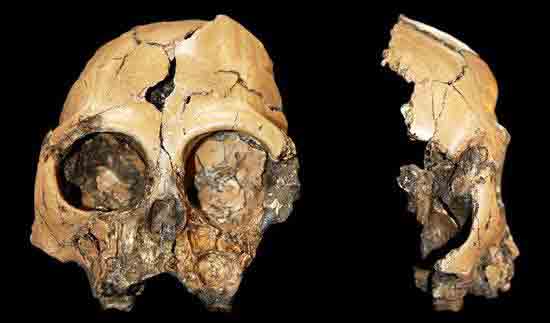A team of researchers has discovered the cranium of a fossil ape from Shuitangba, a Miocene site in Yunnan Province, China. The juvenile cranium of the fossil ape Lufengpithecus is significant, according to team member Nina Jablonski, Distinguished Professor of Anthropology at Penn State.
Jablonski noted that juvenile crania of apes and hominins are extremely rare in the fossil record, especially those of infants and young juveniles. This cranium is only the second relatively complete cranium of a young juvenile in the entire Miocene — 23-25 million years ago — record of fossil apes throughout the Old World, and both were discovered from the late Miocene of Yunnan Province.
The cranium is also noteworthy for its age. Shuitangba, the site from which it was recovered, at just over 6 million years old, dates to near the end of the Miocene, a time when apes had become extinct in most of Eurasia. Shuitangba has also produced remains of the fossil monkey, Mesopithecus, which represents the earliest occurrence of monkeys in East Asia.
Jablonski was co-author of a recent paper online in the Chinese Science Bulletin that described the discovery.
“The preservation of the new cranium is excellent, with only minimal post-depositional distortion,” Jablonski said. “This is important because all previously discovered adult crania of the species to which it is assigned, Lufengpithecus lufengensis, were badly crushed and distorted during the fossilization process. In living ape species, cranial anatomy in individuals at the same stage of development as the new fossil cranium already show a close resemblance to those of adults.”
Therefore, the new cranium, despite being from a juvenile, gives researchers the best look at the cranial anatomy of Lufengpithecus lufengensis.
“Partly because of where and when Lufengpithecus lived, it is considered by most to be in the lineage of the extant orangutan, now confined to Southeast Asia but known from the late Pleistocene of southern China as well,” Jablonski said.
However, the researchers noted the cranium shows little resemblance to those of living orangutans, and in particular, shows none of what are considered to be key diagnostic features of orangutan crania. Lufengpithecus therefore appears to represent a late surviving lineage of Eurasian apes, but with no certain affinities yet clear.
The survival of this lineage is not entirely surprising since southern China was less affected by climatic deterioration during the later Miocene that resulted in the extinction of many ape species throughout the rest of Eurasia. The researchers are hopeful that further excavations will produce the remains of adult individuals, which will allow them to better assess the relationships among members of this lineage as well as the relationships of this lineage to other fossil and extant apes.

